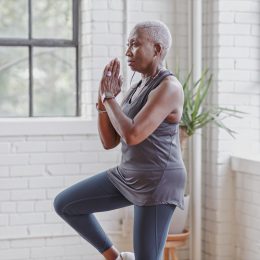Find Your Place: Assess Your Agility
This important test can reveal how safely and quickly you can change directions—and your risk of falls.
How long does it take you to get up from a chair, walk 10 feet, turn around, and return to your seat? Now, what if you turn in the opposite direction? In this video, SilverSneakers fitness expert David Jack explains how the timed get up and go test can give you clues about your agility, vestibular health, and risk of falls.
You’ll need:
- A stopwatch
- A sturdy chair
- A ruler or tape measure
- Non-clear tape or sticky notes
- Ideally, a partner to walk with you and keep time on the stopwatch for you
Try the test now, then see what your results mean below. If you’re not able to stand and walk safely, or have balance issues, skip the test, but check out the tips below.
If Your Time Was Less Than 7.4 Seconds
That’s a sign your agility is above average. Agility is the ability to change directions safely and quickly. What helps make it possible: your vestibular system, made up of parts of your inner ear and brain. Its job is to let you know where you are in space—and if you need to adjust your balance and positioning.
Hone this critical skill with these eight exercises that improve agility. Or challenge yourself with upbeat SilverSneakers classes, dancing, tennis, or any activity that gets your body moving in many different ways.
If Your Time Was 7.5 to 13.5 Seconds
That’s a sign your agility is average. In general, someone in their 60s or 70s will likely have a faster time than someone in their 80s or 90s.
Another quick check: During the test, did you feel dizzy or unsteady? If so, skip to the section below, and make a plan to talk to your doctor.
If you felt steady throughout the test, you’ll want to stay as agile as you are now—and improve if you can. Try this: Add the toe tap heel tap exercise to your weekly or daily routine. Move slowly, and focus on getting the footwork right first. As you gain confidence, you can pick up the speed.
If Your Time Was Above 13.5 Seconds—or You Felt Dizzy
That’s a sign you’re at a higher risk of falls. This could be due to a number of reasons: weakness or imbalance in the lower body, an inner ear problem that affects your sense of balance, vision changes that prevent you from seeing the floor clearly, and even medication side effects.
Your action plan: Talk to your doctor about your current health and all your medications. Let your doctor know if:
Subscribe to our newsletter
It's quick and easy. You could be one of the 13 million people who are eligible.
Already a member? Click to discover our 15,000+ participating locations.
Follow Us
- You’ve fallen in the past year
- You feel unsteady when standing or walking
- You worry about falling
Plus, check out these steps you can take to prevent falls at home.
If You Have Previously Fallen
You’ll want to work with your doctor to get back to safe movement. Ask these six questions.
Need some inspiration? Check out this story about a SilverSneakers member who fell on concrete several times—but regained her fitness through strength training and yoga.
Check Your SilverSneakers Eligibility Instantly
SilverSneakers members can go to thousands of gyms and fitness locations across the nation, plus take exercise classes designed for seniors and led by supportive instructors. If you have a Medicare Plan, it may include SilverSneakers—at no additional cost. Check your eligibility instantly here.
Already a member? Get your SilverSneakers member ID and exclusive fitness content by logging in to or creating your online account here.





